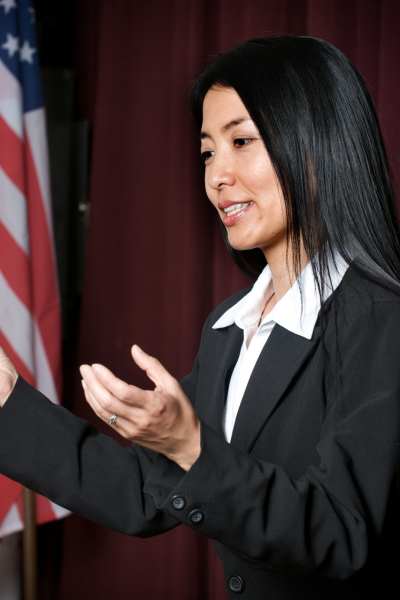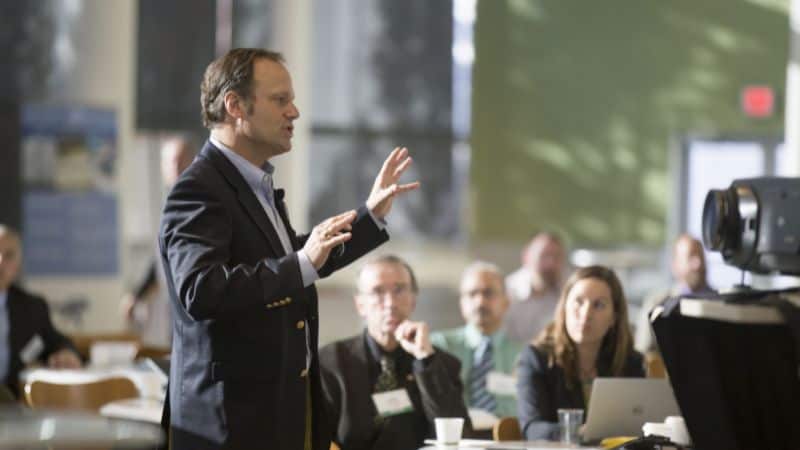Whether you’re a seasoned professional looking to refine your skills or a newcomer eager to overcome your fear of speaking in public, this guide is designed just for you.
Public speaking is a skill that can open countless doors, from career advancement to personal growth, and I’m thrilled to be your guide on this journey.
Why Public Speaking Matters
Public speaking is more than standing in front of a crowd and delivering a speech. Public speaking is about connecting with your audience, sharing your ideas, and inspiring action.
Great speakers can change minds, influence decisions, and leave a lasting impact on the world. The ability to communicate clearly and confidently is more important than ever.
Setting Your 90-Day Mission
Before we dive into the techniques and strategies that will make you a powerful speaker, let’s start with a mission.
Over the next 90 days, embark on a journey to transform your public speaking skills.
Your mission is to set a clear goal for what you want to achieve.
It could be delivering a successful presentation at work, speaking confidently at a community event, or simply feeling more at ease when you speak.
Whatever your goal, write it down and commit to it.
My Approach to Learning
This guide is not just about reading and absorbing information. It’s structured like a workshop, filled with interactive exercises and questions that will help you learn faster and retain more.
Reflect on your experiences, practice new techniques, and track your progress.
Actively engage with the material to see tangible improvements in your speaking skills.
New and Effective Ideas
I will share ideas and strategies that you may not have heard before. These are insights drawn from my 20 years of experience as a professional speaker, combined with the latest research and theories in public speaking.
I will provide you with fresh, effective approaches that will set you apart and make you a more compelling speaker.
What is Public Speaking?
Public speaking is a structured conversation. It begins with you but it is not about you. When you speak, you are inviting your audience to a change journey. Public speaking is leading.
You perform public speaking when you talk before a group of people to share ideas, inform, instruct, entertain, influence, or inspire.
Public speaking is not about something, it is for someone. It begins with you, but is is not just about you.
Public speaking is a chance to connect with others, share what you know, and make a difference in their lives.
Imagine you have a great idea or important information—by speaking up, you can help people understand and benefit from it.
When you focus on helping your audience, you’ll feel more confident and less worried about making mistakes.
Overcome Fear and Be Confident
Many people are afraid of public speaking because they worry about being judged or rejected.
But the fear you feel is normal, and it’s something you can manage.
Think about giving, not performing. Shift your mindset. Instead of seeing public speaking as a performance, see it as a way to help others. When you focus on giving, you’ll feel more relaxed and confident.
Commit to your goal. Decide that sharing your message is more important than staying silent. This commitment will give you the courage to take the first step, and then the next, and the next.
Start small. Begin with small groups to build your confidence gradually.
Know your material. The better you know your topic, the more confident you’ll feel.
Visualize success. Picture yourself giving a great speech. This positive thinking helps reduce fear.
Practice regularly. Confidence comes from doing. The more you practice, the more familiar and comfortable you’ll become. Practice alone, with friends, or in front of a mirror.
Get feedback. Ask for feedback from people you trust and use it to improve.
Learn and improve. Along with practice, you need the right knowledge, attitude, skills, and habits. Read about public speaking, watch great speakers, and apply what you learn. Over time, you’ll see yourself improving.
Public speaking is a powerful way to connect with others and share valuable ideas. Commit to practicing and improving, and remember that each step you take makes you a better speaker.
You may explore the following articles:

Your Purpose in Speaking
Knowing why you’re speaking and who you’re speaking to will help you create a powerful and engaging message.
Identify Your Speaking Goals
First things first: why are you speaking? What do you want to achieve?
Maybe you want to inspire people, share an important message, or teach something new.
Whatever your goal, write it down. When you know your goal, it’s easier to stay focused and deliver a clear message.
Think about this: if you could leave your audience with just one thing, what would it be? That’s your main goal. Keep it simple and straightforward.
Understand Your Audience
Next, think about who you’re speaking to. Understanding your audience is key to connecting with them. Ask yourself these questions:
- Who are they?
- What do they care about?
- What do they already know about your topic?
- What do they want to learn or gain?
When you know your audience, you can tailor your message to meet their needs and interests. This makes your speech more engaging and effective.
Craft a Clear Message
With your goal and audience in mind, it’s time to craft your message. Your message should be clear and easy to understand. Here’s how to do it:
- Start with a Strong Opening: Grab their attention right away. You can start with a question, a surprising fact, or a short story.
- Make Your Main Point: Be clear about what you want to say. State your main point early on so your audience knows what to expect.
- Support Your Point: Use examples, facts, and stories to back up your main point. This helps make your message more interesting and believable.
- End with a Memorable Conclusion: Summarize your main point and leave your audience with something to remember. You can end with a call to action, a powerful quote, or a final thought.
Practice with Purpose
You’ve probably heard the phrase, “Practice makes perfect.” I don’t agree with that. Wrong practice won’t make you speech delivery perfect. And I have not really seen a perfect speech.
But I believe practice provides you the opportunity to experience what you are going to deliver. This helps you solve your problem with anxiety. And with a coach to help you, you can improve your speech every time you practice.
There are also those who tell you to practice in front of a mirror. Practicing with a live audience is much more effective than practicing in front of a mirror. Mirrors don’t have emotions; your audience does.
Remember, public speaking is for someone. It starts with you, but it’s not about you.
The Power of Knowledge and Attitude
To become confident in public speaking, it’s important to gain the right knowledge and have the right attitude.
Consider joining a speaking club like Toastmasters. You’ll get valuable feedback and find mentors who can guide you.
Wrong practice won’t make things perfect. That’s why you need the right knowledge to know what’s good, better, and best. Keep learning and improving your attitude towards public speaking.
Defining your purpose is the first step to becoming a great speaker. Know your goal, understand your audience, and craft a clear, engaging message.

The Mechanics of Speaking
It is time to dive into the mechanics of speaking. This is where we focus on how you deliver your speech—things like your voice, body language, and visual aids.
Voice Control and Modulation
Your voice is one of your most powerful tools in public speaking. How you use it can make a big difference in how your message is received. Here’s how to get started:
- Vary Your Pitch: Don’t speak in a monotone. Change your pitch to keep things interesting. Higher pitches can show excitement, while lower pitches can convey seriousness.
- Control Your Volume: Speak loudly enough to be heard, but don’t shout. Use a microphone if necessary.
- Pace Yourself: Don’t rush. Speaking too quickly can make it hard for your audience to follow. Pause for effect and give your listeners time to absorb your points.
- Practice Pronunciation: Make sure you’re pronouncing words clearly. This helps your audience understand you better.
Body Language and Gestures
Your body language can say a lot, sometimes even more than your words. Here’s how to use it effectively:
- Stand Tall: Good posture shows confidence. Stand up straight and avoid slouching.
- Make Eye Contact: Look at your audience, not at your notes or the floor. Eye contact helps you connect with your listeners.
- Use Hand Gestures: Don’t keep your hands glued to your sides. Use them to emphasize points, but don’t overdo it.
- Move with Purpose: Don’t pace nervously, but don’t stand like a statue either. Move around the stage to engage different parts of the audience.
Effective Use of Visual Aids
Visual aids can enhance your message and help your audience understand your points better. Here’s how to use them well:
- Keep It Simple: Don’t overload your slides with too much information. Use bullet points, images, and charts to make your points clear.
- Use High-Quality Images: Blurry or low-quality images can distract from your message. Make sure everything is clear and professional.
- Practice with Your Aids: Make sure you know how to use your visual aids smoothly. Practice transitioning between slides and using any equipment.
- Don’t Rely Solely on Visuals: Your slides should support your speech, not replace it. Make sure you’re still engaging with your audience directly.
Putting It All Together
Here are a few steps to get you started with the mechanics of speaking:
- Record Yourself: Practice your speech and record it. Listen for areas where you can improve your voice modulation, pace, and pronunciation.
- Practice in Front of Others: Get feedback on your body language and gestures from friends or family.
- Rehearse with Your Visuals: Make sure you’re comfortable using your visual aids and that they enhance your message.
- Seek Feedback: Ask for constructive feedback and use it to improve. The more you practice and refine your mechanics, the more confident and effective you’ll become.
Understanding the mechanics of speaking helps you deliver your message better.
Pay attention to your voice, body language, and visual aids, so you can make your speeches more engaging and impactful.
I recommend you explore the following articles.
Let’s keep going and master the art of public speaking together!

Crafting Your Speech
The key to a great speech is keeping your audience in mind.
You’re talking to people who have values, needs, and struggles. Your speech should be relevant to them and offer something valuable.
Let’s explore how to craft a speech that truly resonates.
Audience-Centric Approach
When crafting a speech, always start with your audience. Think about who they are and what they care about. Your goal is to address their challenges and show them how you can help. Here’s how to keep your audience at the center of your speech:
- Identify Their Needs: Understand what your audience needs and wants. Are they looking for inspiration, information, or solutions to a problem?
- Address Their Struggles: Acknowledge the challenges they face. Show empathy and let them know you understand their struggles.
- Highlight Your Capabilities: Explain how your skills, knowledge, or experience can help them overcome their challenges.
Structuring Your Speech
Now, let’s break down the structure of your speech into simple, actionable steps. This structure will help you craft a message that resonates with your audience and keeps them engaged from start to finish.
- The Goal of the Audience
- Present Their Story: Start by painting a picture of your audience’s current situation. Highlight their needs, values, and struggles. This helps them see that you understand where they are coming from.
- Example: “Imagine you’re trying to balance work, family, and personal growth, but it feels like there’s never enough time in the day. You’re not alone in this struggle.”
- Their Problem
- Current Reality: Discuss how your audience is currently trying to solve their problems. Explain that their behaviors are influenced by their mindset.
- Examine Mindsets: Help them reflect on whether their current approach is effective.
- Example: “Right now, you might be trying to solve this by working longer hours or sacrificing your personal time, thinking it will help you get ahead.”
- The Promise
- What They Will Gain: Clearly state what your audience will gain by listening to your speech. This is your opportunity to make a compelling promise.
- Example: “By the end of this talk, you’ll discover how to manage your time better and achieve a balanced life without feeling overwhelmed.”
- The Truth (The Aha!)
- Reveal New Insights: Share a truth or insight that your audience may not know. This is often best done through storytelling rather than just presenting facts.
- Example: “Let me tell you a story about Jane, a busy professional like you, who discovered that the key to balance wasn’t working harder, but working smarter.”
- The Change
- Deliver Your Promise: This is the core message of your speech. This is your agenda. Others may call this a solution. This is a new reality you are selling to your audience.
- Example: “The secret lies in prioritizing your tasks and setting boundaries. Jane started using a simple prioritization technique that allowed her to get more done in less time and still have time for herself.”
- The Action
- What They Must Do: End with clear, actionable steps your audience should take after listening to your speech. This is what they need to start doing or stop doing to achieve the promised outcome.
- Example: “Starting today, I want you to list your top three priorities for the week. Focus on these and let go of the less important tasks. This small change can make a big difference.”
Simplifying Audience Analysis
While audience analysis can sometimes seem complicated, it’s simpler than you think. Remember, your audience has challenges, and you have the capabilities to help them. Here’s a quick way to analyze your audience:
- Who Are They?: Think about the demographics, interests, and background of your audience.
- What Do They Need?: Identify their main needs and challenges.
- How Can You Help?: Determine how your speech can address their needs and help them overcome their challenges.
Crafting a speech with your audience in mind is essential for making a meaningful impact.
By understanding their needs, offering a clear promise, and delivering a strong core message, you can create a speech that resonates and motivates.
Remember, the key is to keep it simple, relevant, and actionable. Let’s move on to the next chapter and continue honing your public speaking skills!

The Art of Storytelling
We’ve talked about defining your purpose and crafting your speech. Now, let’s dive into one of the most powerful tools in your public speaking toolbox: storytelling.
Stories captivate, inspire, and make your message memorable. Let’s explore how you can become a master storyteller in your speeches.
Why Stories Matter
Stories have been a fundamental part of human communication for thousands of years. They’re engaging, relatable, and easy to remember.
When you tell a story, you create an emotional connection with your audience. This connection helps them understand and remember your message better than facts and figures alone.
Elements of a Good Story
A good story has several key elements that make it engaging and impactful. Here’s what you need to include:
- Characters: Introduce relatable characters that your audience can connect with. These characters could be real people, fictional ones, or even yourself.
- Setting: Describe the context where the story takes place. This helps set the scene and makes the story more vivid.
- Conflict: Every good story has a challenge or problem that needs to be resolved. This conflict drives the narrative and keeps the audience interested.
- Resolution: Show how the conflict is resolved. This part of the story provides a sense of closure and delivers the lesson or message you want to convey.
- Emotion: Infuse your story with emotions. Whether it’s joy, sadness, fear, or excitement, emotions make your story relatable and memorable.
Integrating Stories into Your Speech
Now that you know the elements of a good story, let’s look at how to integrate stories into your speech. Here are some tips to get you started:
- Start with a Story: Open your speech with a compelling story. This grabs your audience’s attention and sets the stage for your message.
- Use Stories to Illustrate Points: Whenever you make a key point, back it up with a relevant story. This helps reinforce your message and makes it more engaging.
- End with a Story: Conclude your speech with a powerful story that encapsulates your core message. This leaves a lasting impression on your audience.
Crafting Your Story
Let’s walk through the steps of crafting a story for your speech:
- Choose a Relevant Story: Select a story that aligns with your core message and resonates with your audience’s experiences.
- Outline the Key Elements: Identify the characters, setting, conflict, resolution, and emotions in your story. Write a brief outline to organize your thoughts.
- Add Details: Flesh out your story with vivid details. Describe the characters, setting, and emotions to make the story come alive.
- Practice Your Delivery: Practice telling your story multiple times. Pay attention to your tone, pace, and gestures to make the story more engaging.
Examples of Effective Storytelling
To give you an idea of how to use storytelling effectively, here are a couple of examples:
- Personal Experience: Share a personal experience that taught you a valuable lesson. This makes your message authentic and relatable.
- Example: “A few years ago, I faced a major setback at work. I was overwhelmed and unsure of how to move forward. But through perseverance and support from my colleagues, I managed to turn things around. This experience taught me the importance of resilience and teamwork.”
- Case Study: Tell a story about someone else’s experience that illustrates your point.
- Example: “Let me tell you about Jane, a single mother who struggled to balance work and family. By implementing time management strategies, she was able to create a more balanced life and achieve her goals.”
Practice Makes Better
As we discussed earlier, practice doesn’t make perfect, but it provides the opportunity to experience what you’re going to deliver.
The more you practice storytelling, the more comfortable and effective you’ll become.
Practice your stories with a live audience to get feedback and improve your delivery.
Storytelling is a powerful way to connect with your audience and make your message memorable. By incorporating relatable characters, vivid details, and emotional elements, you can create engaging stories that enhance your speeches.
Keep practicing, stay authentic, and watch how your stories captivate and inspire your audience.

Impromptu Speaking Skills
Now that we’ve explored the art of storytelling, let’s dive into a skill that’s always relevant and incredibly important: impromptu speaking.
Among all the forms of public speaking, impromptu speaking has the most universal use.
Whether you’re in a meeting, presenting a report, or asked to give your opinion on the spot, impromptu speaking skills will help you shine. Think of it as a structured conversation.
Let’s explore how you can master this vital skill.
Why Impromptu Speaking Matters
Impromptu speaking is a meta skill.
It’s the ability to organize your thoughts quickly and present them clearly, even when you haven’t prepared in advance.
This skill is useful in many situations, from casual conversations to formal presentations.
Here’s why it’s so important:
- Adaptability: Life is unpredictable, and you won’t always have time to prepare a speech. Being able to speak confidently and clearly on the spot makes you adaptable and resourceful.
- Professional Growth: In the workplace, impromptu speaking skills can set you apart. Whether you’re contributing to a meeting or presenting an idea, your ability to speak well without preparation showcases your expertise and confidence.
- Everyday Conversations: Impromptu speaking isn’t just for formal settings. It’s also about everyday interactions. From chatting with friends to networking events, being able to express your thoughts clearly and confidently makes you a better communicator.
The Structured Conversation Approach
Impromptu speaking can feel daunting, but thinking of it as a structured conversation makes it more manageable. Here’s how to approach it:
- Listen and Understand: The first step in any impromptu speaking situation is to listen carefully. Understand the context and the question or topic at hand. This helps you respond accurately and thoughtfully.
- Organize Your Thoughts: Even without preparation, you can structure your response. Use a simple framework like “point, reason, example, point.” Start with your main point, explain why it’s important, give an example, and then restate your main point.
- Practice and Reflect: Like any skill, impromptu speaking gets better with practice. Take opportunities to practice in meetings, discussions, and social settings. Reflect on your performance and identify areas for improvement.
Tips for Effective Impromptu Speaking
Here are some tips to help you become a confident impromptu speaker:
- Stay Calm: Take a deep breath and stay calm. Nervousness is natural, but staying calm helps you think more clearly.
- Keep It Simple: Don’t overcomplicate your response. Stick to one or two main points and avoid going off on tangents.
- Be Honest: If you don’t know the answer or need a moment to think, it’s okay to say so. Honesty builds trust with your audience.
- Use Personal Stories: Personal stories are powerful in impromptu speaking. They make your response more relatable and engaging.
- Practice Active Listening: Pay attention to what others are saying. This helps you respond more effectively and keeps the conversation flowing.
Practice Makes Better
The more you practice impromptu speaking, the more comfortable and confident you’ll become. Look for opportunities to practice in your daily life, whether it’s in meetings, social gatherings, or casual conversations.
Resources for Further Learning
Don’t forget, there are many articles on my website devoted to impromptu speaking. These resources offer deeper insights and practical tips to help you master this essential skill. Check them out to further enhance your impromptu speaking abilities.
Impromptu speaking is a vital skill that can benefit you in many aspects of life. By thinking of it as a structured conversation and practicing regularly, you can become a confident and effective impromptu speaker.
Keep calm, stay focused, and remember that every opportunity to speak is a chance to improve.

Persuasive Speaking Skills
We’ve covered a lot on public speaking so far, and now we’re diving into one of the most powerful skills you can have as a leader: persuasive speaking.
Persuasive speaking is about connecting with people, influencing their thoughts, and inspiring them to take action.
As a professional speaker, I often meet with CEOs to sell ways to develop leaders, and persuasive speaking is my secret weapon.
The Power of Persuasion
Persuasion is more than just presenting facts and figures; it’s about making your ideas compelling and motivating others to act.
When I speak with CEOs, my goal is to influence their thinking and inspire them to invest in leadership development.
Persuasive speaking allows you to align your message with your audience’s values and needs, making it irresistible.
Techniques for Persuasive Speaking
To persuade effectively, use these techniques:
- Know Your Audience: Understand their values, needs, and pain points. CEOs, for instance, are often focused on ROI and strategic growth. Tailor your message to address these priorities.
- Find Your Red Thread: Tamsen Webster’s concept of the “red thread” is about connecting your big idea to what your audience cares about. Identify this connection and weave it throughout your speech.
- Make an Irresistible Offer: Clearly articulate the benefits and value of your idea. Show how your solution directly addresses their challenges and helps them achieve their goals.
- Use Emotional Appeal: Facts and data are important, but stories and emotions drive decisions. Share compelling stories that evoke emotions and illustrate the impact of your ideas.
- Establish Credibility: Demonstrate your expertise and reliability. Share your background, successes, and relevant experiences to build trust.
- Structure Your Argument: Present your ideas logically. Start with a strong opening, build your case with evidence and examples, and conclude with a powerful closing that reinforces your message.
- Use Repetition: Reinforce key points by repeating them throughout your speech. This makes your message more memorable and impactful.
- Address Counterarguments: Anticipate objections and address them head-on. This shows you’ve thought through your ideas and are prepared to defend them.
Crafting Your Persuasive Speech
Let’s revisit the framework we discussed in Chapter 4, tailored for persuasive speeches:
- The Goal of the Audience
- Present Their Story: Start by painting a picture of your audience’s current situation. Highlight their needs, values, and struggles. This helps them see that you understand where they are coming from.
- Example: “Imagine you’re a CEO trying to drive growth and innovation in a rapidly changing market. You’re juggling multiple priorities and looking for ways to stay ahead.”
- Their Present Mindset and Behaviors
- Current Solutions: Discuss how your audience is currently trying to solve their problems. Explain that their behaviors are influenced by their mindset.
- Examine Mindsets: Help them reflect on whether their current approach is effective.
- Example: “Right now, you might be investing heavily in technology and processes, thinking it will give you the competitive edge. But are these investments really paying off?”
- The Promise
- What They Will Gain: Clearly state what your audience will gain by listening to your speech. This is your opportunity to make a compelling promise.
- Example: “By the end of this talk, you’ll discover how investing in leadership development can drive innovation and growth, giving you a sustainable competitive advantage.”
- The Truth (They Don’t Know Yet)
- Reveal New Insights: Share a truth or insight that your audience may not know. This is often best done through storytelling rather than just presenting facts.
- Example: “Let me tell you about a company that transformed its performance by focusing on developing its leaders. They saw a 30% increase in productivity and a 20% boost in employee engagement.”
- The Fulfillment
- Deliver Your Promise: This is the core message of your speech. Provide the solution to their challenges and explain how it will help them achieve their goals.
- Example: “The secret lies in empowering your leaders with the skills and mindset to drive change. By investing in leadership development, you can create a culture of innovation and resilience.”
- The Action
- What They Must Do: End with clear, actionable steps your audience should take after listening to your speech. This is what they need to start doing or stop doing to achieve the promised outcome.
- Example: “Starting today, commit to developing your leaders. Invest in training programs, create mentoring opportunities, and foster a culture of continuous learning.”
Real-World Application
When I meet with CEOs, I use this framework to persuade them to invest in leadership development programs. Here’s how I do it:
- Understanding Their Needs: I research their company, understand their challenges, and tailor my message to show how leadership development can address their specific needs.
- Making a Compelling Case: I share success stories of other companies that have benefited from similar programs. This helps illustrate the potential impact and ROI.
- Building Trust: I highlight my experience and successes in the field, establishing my credibility and reliability.
- Engaging Emotions: I use stories of leaders who transformed their teams and achieved remarkable results, evoking emotions that resonate with the CEOs’ goals.
- Addressing Concerns: I anticipate and address any concerns they might have, such as budget constraints or implementation challenges, showing that I’ve thought through the details.
Practicing Persuasive Speaking
Persuasive speaking, like any skill, improves with practice. Here are some tips to help you practice:
- Record Yourself: Record your speeches and review them to identify areas for improvement.
- Seek Feedback: Ask for feedback from trusted colleagues or mentors and use it to refine your approach.
- Practice in Real Situations: Look for opportunities to practice persuasive speaking in meetings, presentations, and everyday conversations.
- Study Great Speakers: Watch speeches by great persuasive speakers and analyze their techniques. Learn from their style and approach.
Persuasive speaking is a game-changer for leaders.
Remember, it’s not just about what you say, but how you say it. Keep these techniques in mind, practice them diligently, and watch yourself grow as a persuasive speaker.
Let’s move on to the next chapter and continue mastering the art of public speaking!



